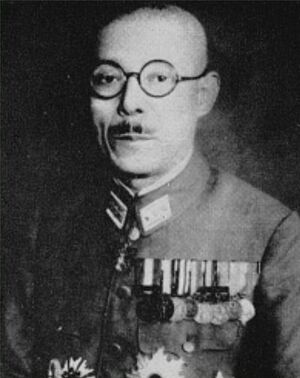Heitarō Kimura facts for kids
Quick facts for kids
Heitarō Kimura
|
|
|---|---|
 |
|
| Born | 28 September 1888 |
| Died | 23 December 1948 (aged 60) Sugamo Prison, Tokyo, Occupied Japan
|
| Criminal status | Held accountable |
| Conviction(s) | Found responsible for serious actions during wartime |
| Trial | International Military Tribunal for the Far East |
| Criminal penalty | Severe consequences |
| Military career | |
| Allegiance | |
| Service/ |
|
| Years of service | 1908–1945 |
| Rank | |
| Commands held | 32nd Division Burma Area Army |
| Battles/wars | Siberian Intervention Second Sino-Japanese War World War II |
Heitarō Kimura (木村 兵太郎, Kimura Heitarō (sometimes Kimura Hyōtarō), 28 September 1888 – 23 December 1948) was a high-ranking general in the Imperial Japanese Army. After World War II, he was found responsible for certain actions during the war by a special court.
Contents
Early Life and Military Training
Kimura was born in Saitama prefecture, which is north of Tokyo, Japan. However, he grew up in Hiroshima prefecture, which he thought of as his true home.
He started his military education when he was quite young. He graduated from the Imperial Japanese Army Academy in 1908. Later, in 1916, he also graduated from the Army War College. He then became an officer in the artillery, which is a part of the army that uses large guns.
Early Career and Diplomatic Roles
From 1918 to 1919, Kimura served during the Japanese Siberian Intervention. This was when Japan supported some Russian forces against the Bolshevik Red Army. After this, he was sent to Germany as a military attaché. This means he was a military officer working at an embassy to share information.
In the late 1920s, Kimura worked with the Inspectorate of Artillery. He also taught at the Field Artillery School. He was chosen to be part of the Japanese team at the London Disarmament Conference from 1929 to 1931. This conference was about reducing the number of warships countries could have.
When he returned to Japan, he was promoted to lieutenant colonel. He was given command of the IJA 22nd Artillery Regiment. From 1932 to 1934, he went back to teaching. He taught at both the Field Artillery School and the Coastal Artillery School.
Important Roles in Government and Army
In 1935, Kimura started to have a bigger role in Japanese policy. He became the Chief of the Control Section in the Economic Mobilisation Bureau at the Ministry of War. The next year, he became the Head of the Ordnance Bureau. He was promoted to major general in 1936.
He became a lieutenant general in 1939. He was then given a combat command with the IJA 32nd Division in China from 1939 to 1940. From 1940 to 1941, Kimura served as the Chief of Staff for the Kwantung Army in Manchukuo.
Kimura returned to the Ministry of War in 1941. He became the Vice Minister of War. In this role, he helped War Minister Hideki Tōjō plan strategies for campaigns in the Second Sino-Japanese War and the Pacific War. From 1943 to 1944, he was a member of the Supreme War Council. Here, he continued to have a big impact on military plans and decisions.
Command in Burma During World War II
Late in 1944, the war was not going well for Japan. After the difficult Battle of Imphal, Kimura was sent to lead troops in the field again. This time, he was the commander in chief of the Burma Area Army. His job was to defend Burma against the Allied forces.
The situation was very tough. Japanese forces were under a lot of pressure, and the Allies had complete control of the sky. There were not enough new soldiers or supplies. Kimura tried to defend Burma by falling back behind the Irrawaddy River. He hoped to attack the Allies when their supply lines were stretched out. This move did cause some problems for the Allies at first.
However, the Allies had much more equipment and supplies. They changed their main attack, and important places like Meiktila and Mandalay were captured during the Battle of Meiktila and Mandalay. After this, Kimura could only try to slow down the Allied advance. He chose to save his forces rather than defend the capital, Rangoon, to the very end. He was promoted to the rank of general in 1945. He was still reorganizing his forces when Japan surrendered in mid-1945.
After World War II
After World War II ended, Kimura was arrested by the Allied occupation powers. He was put on trial by the International Military Tribunal for the Far East. This court looked into actions during the war.
The court noted his role in planning war strategies in China and Southeast Asia. He was also found responsible for not stopping the harsh treatment of prisoners of war in Burma. Even though the Death Railway was built before he arrived in Burma, Kimura was also held responsible for the difficult conditions and suffering of the prisoners of war and civilian workers who built the railroad.
In 1948, he was found responsible for serious actions during the war. He faced severe consequences for these actions.
See also
Images for kids


